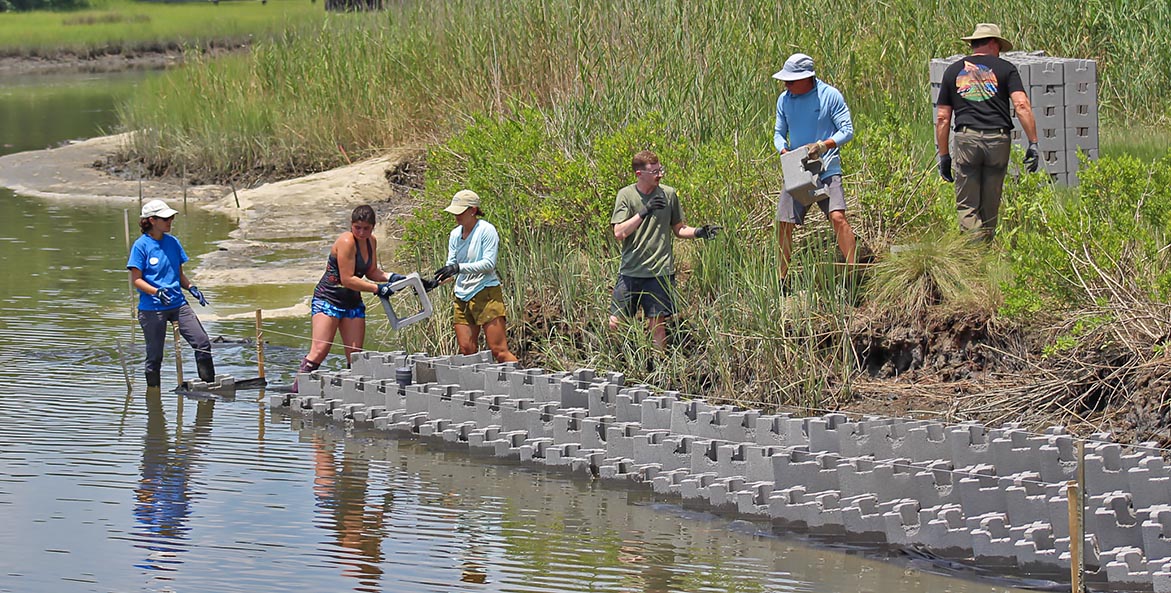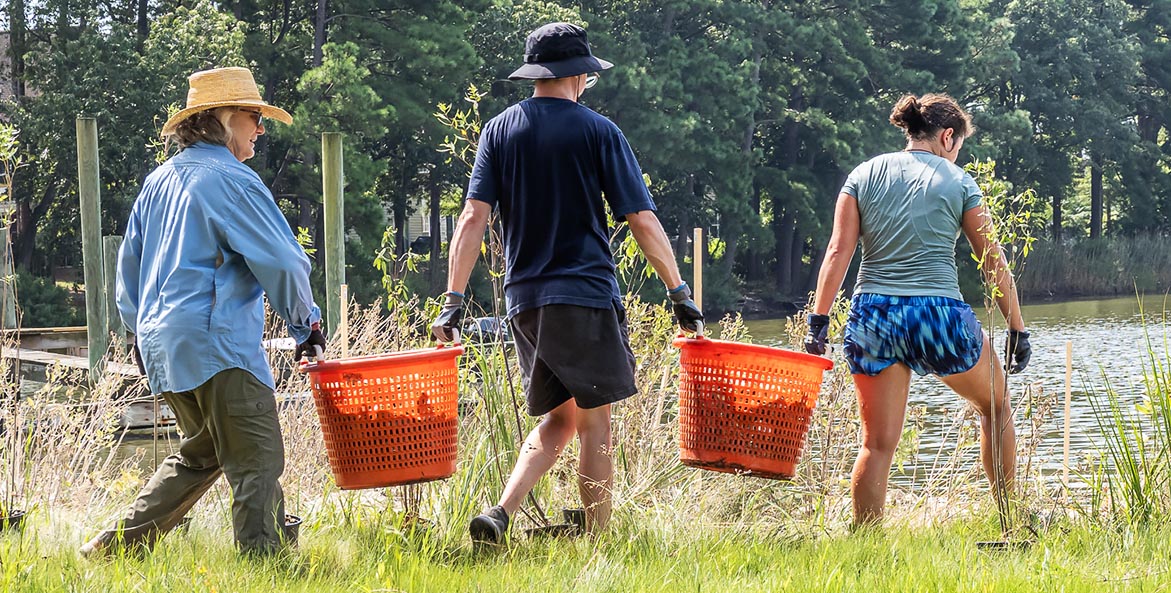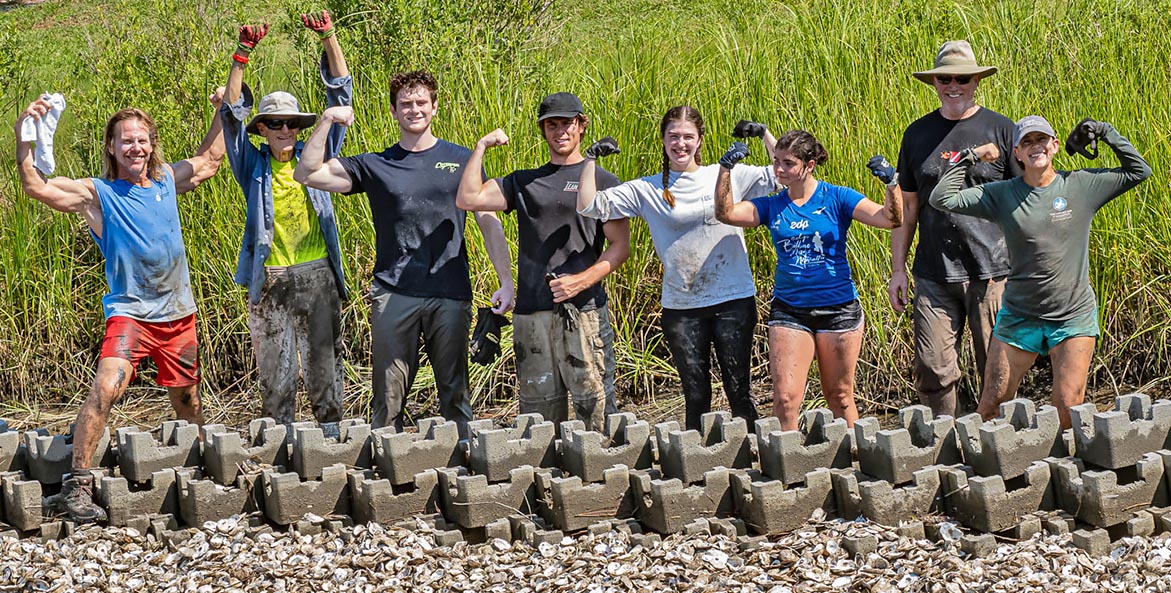What happens when dozens of people volunteer together one summer to restore a tidal shoreline? They not only help save the Bay—they end up creating community.
Last summer Kati Grigsby, a CBF restoration specialist, managed the installation of an impressively large 718-foot living shoreline of oyster reefs and marsh vegetation at a waterfront home in Portsmouth, Virginia. Over the course of 10 weeks, about 90 volunteers worked on the project—ranging from the recently retired to graduate students to members of the military, and more.
The effort ended up evolving into something surprising.
“People became invested. I wasn’t expecting that,” Grigsby said.
Every morning, she assigned an eclectic variety of tasks: fishing oysters out of the marsh, hauling heavy wheelbarrows full of sand, placing “oyster castles” in the water, planting native grasses, and filling sacks with shells, to name a few.

Volunteers place oyster castles that will form part of a new oyster reef at a living shoreline project in Portsmouth, Virginia.
CBF Staff
“Most thought this was never going to work,” Grigsby said. “Slowly they came to understand that there was a method to the madness.”
The process unfolded on the Berner family’s property, who for more than a decade have lived on a point jutting into a branch of the Elizabeth River. Over the years, the Berners watched erosion and storms steadily eat away at their waterfront property.
Avid anglers, the family was interested in creating a living shoreline that could both preserve their land and create habitat for fish, crabs, and oysters.
Rather than hard barriers like bulkheads or riprap, living shorelines use natural systems to make waterfront property more resilient to erosion and sea level rise. Living shorelines also reduce pollution, beautify the waterway, and create habitat.
The landmark Comprehensive Evaluation of System Response (CESR) study is currently shaping the next stage of watershed restoration. It calls for expanding the focus of Bay restoration efforts from solely reducing pollution to also improving habitat in shallow water areas, which is a key benefit of living shorelines. At the Berner property, a new oyster reef will break up wave energy, while a buffer of native grasses and plants will absorb waves and rising waters while holding soil in place.
CBF worked closely with the Elizabeth River Project to make the Berner shoreline a reality. Funding for the materials came from a Virginia Environmental Endowment grant, while volunteers provided the labor. Altogether, they installed 400 tons of sand, 2,400 oyster castles, 27 coconut fiber coir logs, 1,150 bushels of loose oyster shells, 35 bushels of live oysters, and 2,500 wetland plant plugs.

Volunteers work together to carry bushels of recycled oyster shells that will be used to build a reef along the Berner living shoreline in Portsmouth.
Sue Mangan
Amid the dozens of volunteers, a core group of about six to eight people showed up day after day, week after week, in the height of the summer heat.
“It’s 100 degrees and they are covered in mud, and they are smiling and they’re happy to be there. That’s dedication,” said Sue Mangan, a CBF volunteer who photographed the project from start to finish. “There is camaraderie, you become a team with inside jokes. It became a family.”
Jimmy Entas of Norfolk was one of those core volunteers. “I’ve been aware and a proponent of cleaning the Bay most of my conscious life,” Entas said. “I do a lot of random stuff. I live close to the Elizabeth River Trail. All of the restoration stuff, when it hit my radar, I got into it. I get obsessed with things.”
Nicholas Bemish, another frequent volunteer, came to the project soon after retiring from 40 years of federal service. He was looking for new opportunities to help the community.
“I was just one of many enthusiastic and motivated volunteers and was happy to work with so many local people with the same desire to see a healthy Bay,” Bemish said. “Mucking around in the marsh in the hottest part of the summer is probably not everyone’s first choice, but everybody (Kati more than all of us) got in the mud and got the job done.”
Volunteers savored the moments at the end of each day when Grigsby would cut up cold fruit to pass around. “When we were done and sweaty, I’d cut fruit and we’d share watermelon, oranges, and mangoes,” Grigsby said. “People would sit for 30 minutes and reflect on what we did and what we were going to do the next day.”
The Berner Shoreline, as it came to be called, is unusually big for a living shoreline at a private residence. It could become a model for similar efforts in the future. While many large living shorelines are installed by contractors, the volunteer effort became an unexpected opportunity for many to grow and bond.
What kept people coming back day after day was the satisfaction of working together toward a common goal: cleaner water and a healthier Chesapeake Bay.
“There was a sense of purpose. They could see the project for what it was becoming,” Mangan said. “This one captured their attention.”




